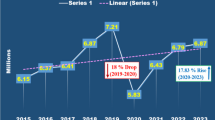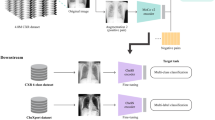Abstract
Early tuberculosis (TB) screening through chest X-rays (CXRs) is essential for timely detection and treatment of the disease. Previous studies have shown that texture abnormalities in CXRs can be enhanced by bone suppression techniques, which may potentially improve TB diagnosis performance. However, existing TB datasets with CXRs usually lack bone-suppressed images, making it difficult to take advantage of bone suppression for TB recognition. Also, existing bone suppression models are usually trained on a relatively small dual-energy subtraction (DES) dataset with CXRs, without considering the image specificity of TB patients. To this end, we propose a bone-suppressed CXR-based tuberculosis recognition (BCTR) framework, where diagnosis-specific deep features are extracted and used to guide a bone suppression (BS) model to generate bone-suppressed CXRs for TB diagnosis. Specifically, the BCTR consists of a classification model for TB diagnosis and an image synthesis model for bone suppression of CXRs. The classification model is first trained on original CXRs from multiple TB datasets such as the large-scale TBX11K. The image synthesis model is trained on a DES dataset to produce bone-suppressed CXRs. Considering the heterogeneity of CXR images from the TB datasets and the DES dataset, we proposed to extract multi-scale task-specific features from the trained classification model and transfer them (via channel-wise addition) to the corresponding layers in the image synthesis model to explicitly guide the bone suppression process. With the bone-suppressed CXRs as input, the classification model is further trained for multi-class TB diagnosis. Experimental results on five TB databases and a DES dataset suggest that our BCTR outperforms previous state-of-the-arts in automated tuberculosis diagnosis.
Access this chapter
Tax calculation will be finalised at checkout
Purchases are for personal use only
Similar content being viewed by others
References
Jaeger, S., et al.: Automatic tuberculosis screening using chest radiographs. IEEE Trans. Med. Imaging 33(2), 233–245 (2013)
Konstantinos, A.: Testing for tuberculosis (2010)
Van Cleeff, M., Kivihya-Ndugga, L., Meme, H., Odhiambo, J., Klatser, P.: The role and performance of chest x-ray for the diagnosis of tuberculosis: a cost-effectiveness analysis in Nairobi, Kenya. BMC Infect. Dis. 5(1), 1–9 (2005)
Li, F., Engelmann, R., Pesce, L.L., Doi, K., Metz, C.E., MacMahon, H.: Small lung cancers: improved detection by use of bone suppression imaging–comparison with dual-energy subtraction chest radiography. Radiology 261(3), 937–949 (2011)
Maduskar, P., Hogeweg, L., Philipsen, R., Schalekamp, S., Van Ginneken, B.: Improved texture analysis for automatic detection of tuberculosis (TB) on chest radiographs with bone suppression images. In: Medical Imaging 2013: Computer-Aided Diagnosis, vol. 8670, p. 86700H. International Society for Optics and Photonics (2013)
Schalekamp, S., van Ginneken, B., Schaefer-Prokop, C., Karssemeijer, N.: Impact of bone suppression imaging on the detection of lung nodules in chest radiographs: analysis of multiple reading sessions. In: Medical Imaging 2013: Image Perception, Observer Performance, and Technology Assessment, vol. 8673, p. 86730Y. International Society for Optics and Photonics (2013)
Miyoshi, T., et al.: Effectiveness of bone suppression imaging in the detection of lung nodules on chest radiographs. J. Thorac. Imaging 32(6), 398–405 (2017)
Gordienko, Y., et al.: Deep learning with lung segmentation and bone shadow exclusion techniques for chest X-ray analysis of lung cancer. In: Hu, Z., Petoukhov, S., Dychka, I., He, M. (eds.) ICCSEEA 2018. AISC, vol. 754, pp. 638–647. Springer, Cham (2019). https://doi.org/10.1007/978-3-319-91008-6_63
Loog, M., van Ginneken, B., Schilham, A.M.: Filter learning: application to suppression of bony structures from chest radiographs. Med. Image Anal. 10(6), 826–840 (2006)
Oh, D.Y., Yun, I.D.: Learning bone suppression from dual energy chest X-rays using adversarial networks. arXiv preprint arXiv:1811.02628 (2018)
Zarshenas, A., Liu, J., Forti, P., Suzuki, K.: Separation of bones from soft tissue in chest radiographs: anatomy-specific orientation-frequency-specific deep neural network convolution. Med. Phys. 46(5), 2232–2242 (2019)
Eslami, M., Tabarestani, S., Albarqouni, S., Adeli, E., Navab, N., Adjouadi, M.: Image to images translation for multi-task organ segmentation and bone suppression in chest X-ray radiography. arXiv preprint arXiv:1906.10089 (2019)
Pan, Y., Liu, M., Lian, C., Xia, Y., Shen, D.: Disease-image specific generative adversarial network for brain disease diagnosis with incomplete multi-modal neuroimages. In: Shen, D., et al. (eds.) MICCAI 2019. LNCS, vol. 11766, pp. 137–145. Springer, Cham (2019). https://doi.org/10.1007/978-3-030-32248-9_16
Liu, Y., et al.: Joint neuroimage synthesis and representation learning for conversion prediction of subjective cognitive decline. In: Martel, A.L., et al. (eds.) MICCAI 2020. LNCS, vol. 12267, pp. 583–592. Springer, Cham (2020). https://doi.org/10.1007/978-3-030-59728-3_57
Liu, Y., Wu, Y.H., Ban, Y., Wang, H., Cheng, M.M.: Rethinking computer-aided tuberculosis diagnosis. In: Proceedings of the IEEE/CVF Conference on Computer Vision and Pattern Recognition, pp. 2646–2655 (2020)
Jaeger, S., Candemir, S., Antani, S., Wáng, Y.X.J., Lu, P.X., Thoma, G.: Two public chest x-ray datasets for computer-aided screening of pulmonary diseases. Quant. Imaging Med. Surg. 4(6), 475 (2014)
Chauhan, A., Chauhan, D., Rout, C.: Role of gist and PHOG features in computer-aided diagnosis of tuberculosis without segmentation. PLoS ONE 9(11), e112980 (2014)
He, K., Zhang, X., Ren, S., Sun, J.: Identity mappings in deep residual networks. In: Leibe, B., Matas, J., Sebe, N., Welling, M. (eds.) ECCV 2016. LNCS, vol. 9908, pp. 630–645. Springer, Cham (2016). https://doi.org/10.1007/978-3-319-46493-0_38
Ronneberger, O., Fischer, P., Brox, T.: U-Net: convolutional networks for biomedical image segmentation. In: Navab, N., Hornegger, J., Wells, W.M., Frangi, A.F. (eds.) MICCAI 2015. LNCS, vol. 9351, pp. 234–241. Springer, Cham (2015). https://doi.org/10.1007/978-3-319-24574-4_28
Liu, W., et al.: SSD: single shot multibox detector. In: Leibe, B., Matas, J., Sebe, N., Welling, M. (eds.) ECCV 2016. LNCS, vol. 9905, pp. 21–37. Springer, Cham (2016). https://doi.org/10.1007/978-3-319-46448-0_2
Lin, T.Y., Goyal, P., Girshick, R., He, K., Dollár, P.: Focal loss for dense object detection. In: Proceedings of the IEEE International Conference on Computer Vision, pp. 2980–2988 (2017)
Ren, S., He, K., Girshick, R., Sun, J.: Faster R-CNN: towards real-time object detection with region proposal networks. arXiv preprint arXiv:1506.01497 (2015)
Tian, Z., Shen, C., Chen, H., He, T.: FCOS: fully convolutional one-stage object detection. In: Proceedings of the IEEE/CVF International Conference on Computer Vision, pp. 9627–9636 (2019)
Huang, G., Liu, Z., Van Der Maaten, L., Weinberger, K.Q.: Densely connected convolutional networks. In: Proceedings of the IEEE Conference on Computer Vision and Pattern Recognition, pp. 4700–4708 (2017)
Wang, Z., Bovik, A.C., Sheikh, H.R., Simoncelli, E.P.: Image quality assessment: from error visibility to structural similarity. IEEE Trans. Image Process. 13(4), 600–612 (2004)
Minaee, S., Kafieh, R., Sonka, M., Yazdani, S., Soufi, G.J.: Deep-covid: Predicting covid-19 from chest x-ray images using deep transfer learning. Med. Image Anal. 65, 101794 (2020)
Acknowledgements
Y. Liu, and W. Yang were partially supported by the National Natural Science Foundation of China (No. 81771916) and the Guangdong Provincial Key Laboratory of Medical Image Processing (No. 2014B-030301042).
Author information
Authors and Affiliations
Corresponding author
Editor information
Editors and Affiliations
Rights and permissions
Copyright information
© 2021 Springer Nature Switzerland AG
About this paper
Cite this paper
Liu, Y., Qin, G., Liu, Y., Liu, M., Yang, W. (2021). Improving Tuberculosis Recognition on Bone-Suppressed Chest X-Rays Guided by Task-Specific Features. In: Rekik, I., Adeli, E., Park, S.H., Schnabel, J. (eds) Predictive Intelligence in Medicine. PRIME 2021. Lecture Notes in Computer Science(), vol 12928. Springer, Cham. https://doi.org/10.1007/978-3-030-87602-9_6
Download citation
DOI: https://doi.org/10.1007/978-3-030-87602-9_6
Published:
Publisher Name: Springer, Cham
Print ISBN: 978-3-030-87601-2
Online ISBN: 978-3-030-87602-9
eBook Packages: Computer ScienceComputer Science (R0)





